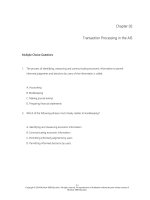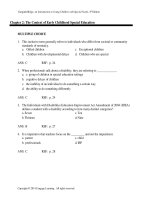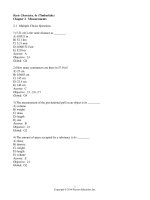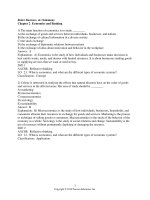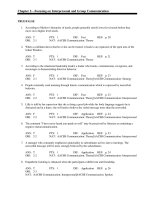BCOM 4th edition lehman test bank
Bạn đang xem bản rút gọn của tài liệu. Xem và tải ngay bản đầy đủ của tài liệu tại đây (336.05 KB, 11 trang )
Chapter 2—Focusing on Interpersonal and Group Communication
TRUE/FALSE
1. According to Maslow's hierarchy of needs, people generally satisfy lower level needs before they
move on to higher level needs.
ANS: T
OBJ: 2-1
PTS: 1
DIF: Fact
NAT: AACSB Communication: Theory
REF: p. 20
2. When a confidant shows that he or she can be trusted, it leads to an expansion of the open area of the
Johari Window.
ANS: T
OBJ: 2-1
PTS: 1
DIF: Fact
NAT: AACSB Communication: Theory
REF: p. 21
3. According to the situational leadership model, a leader who listens, communicates, recognizes, and
encourages is demonstrating directive behavior.
ANS: F
OBJ: 2-1
PTS: 1
DIF: Fact
REF: p. 23
NAT: AACSB Communication: Theory|AACSB Communication: Strategy
4. People constantly send meaning through kinesic communication which is expressed by nonverbal
behavior.
ANS: T
OBJ: 2-2
PTS: 1
DIF: Fact
REF: p. 23
NAT: AACSB Communication: Theory|AACSB Communication: Interpersonal
5. Lilly is told by her supervisor that she is doing a good job while his body language suggests he is
distracted and in a hurry; she will tend to believe the verbal message more than the nonverbal.
ANS: F
OBJ: 2-2
PTS: 1
DIF: Application REF: p. 24
NAT: AACSB Communication: Theory|AACSB Communication: Interpersonal
6. The comment “I have never heard you speak so well” may be perceived by listeners as containing a
negative metacommunication.
ANS: T
OBJ: 2-2
PTS: 1
DIF: Application REF: p. 23
NAT: AACSB Communication: Theory|AACSB Communication: Interpersonal
7. A manager who constantly emphasizes punctuality to subordinates arrives late to meetings. The
nonverbal message will be more strongly believed by the subordinates.
ANS: T
OBJ: 2-2
PTS: 1
DIF: Application REF: p. 24
NAT: AACSB Communication: Theory|AACSB Communication: Interpersonal
8. Empathetic listening is enhanced when the participants exhibit trust and friendship.
ANS: T
PTS: 1
DIF: Application REF: p. 26
OBJ: 2-3
NAT: AACSB Communication: Interpersonal|AACSB Communication: Spoken
9. Performance appraisal interviews between supervisors and employees frequently combine listening
intensively and empathetic listening.
ANS: T
PTS: 1
DIF: Application REF: p. 25
OBJ: 2-3
NAT: AACSB Communication: Interpersonal|AACSB Communication: Spoken
10. A student who is listening to instructions for a homework assignment should be using casual listening
skills.
ANS: F
PTS: 1
DIF: Application REF: p. 25
OBJ: 2-3
NAT: AACSB Communication: Interpersonal|AACSB Communication: Spoken
11. Listening commonly consumes more of a business employee's time than reading, writing, and speaking
combined.
ANS: T
PTS: 1
DIF: Fact
REF: p. 26
OBJ: 2-3
NAT: AACSB Communication: Interpersonal|AACSB Communication: Spoken
12. Effective listening involves observing nonverbal communication as well as hearing the verbal
message.
ANS: T
PTS: 1
DIF: Fact
REF: p. 28
OBJ: 2-3
NAT: AACSB Communication: Interpersonal|AACSB Communication: Spoken
13. The terms role and status are used interchangeably to indicate the part people play in the organization.
ANS: F
OBJ: 2-4
PTS: 1
DIF: Fact
NAT: AACSB Teams
REF: p. 27
14. Kelly, who is on Team A, constantly complains and criticizes her team members; she is playing the
role of detractor.
ANS: T
OBJ: 2-4
PTS: 1
DIF: Application
NAT: AACSB Teams
REF: p. 30
15. In a flat organization structure, communicating among the cross-disciplinary teams becomes more
important than upward and downward communication.
ANS: T
OBJ: 2-4
PTS: 1
DIF: Application
NAT: AACSB Teams
REF: p. 27
16. While research has not determined the optimal number of members for effective group work, an odd
number offers some advantage.
ANS: T
OBJ: 2-4
PTS: 1
DIF: Fact
NAT: AACSB Teams
REF: p. 29
17. A task force is an example of a long-standing team or group.
ANS: F
PTS: 1
DIF: Fact
REF: p. 31
OBJ: 2-4
NAT: AACSB Teams
18. Major distinctions between a group and a team are the members' cooperative attitude and level of
commitment.
ANS: T
OBJ: 2-4
PTS: 1
DIF: Fact
NAT: AACSB Teams
REF: p. 31
19. Given enough time, all groups advance through the four stages of team development that include
forming, storming, norming, and performing.
ANS: F
OBJ: 2-4
PTS: 1
DIF: Application REF: p. 31
NAT: AACSB Teams |AACSB Communication: Interpersonal
20. Despite the growth in popularity of electronic meetings, face-to-face meetings continue to be the
most-used meeting format in most organizations.
ANS: T
OBJ: 2-5
PTS: 1
DIF: Fact
REF: p. 33
NAT: AACSB Communication: Meetings|AACSB Technology
21. Electronic meetings are preferred to face-to-face meetings when group efforts are just beginning and
members are trying to build group values.
ANS: F
OBJ: 2-5
PTS: 1
DIF: Fact
REF: p. 33
NAT: AACSB Communication: Meetings|AACSB Technology
22. Using an electronic meeting process can reduce meeting time significantly.
ANS: T
OBJ: 2-5
PTS: 1
DIF: Fact
REF: p. 33
NAT: AACSB Communication: Meetings|AACSB Technology
23. Consensus is the collective opinion of a group, even though each member may not agree with every
aspect of the decision.
ANS: T
OBJ: 2-5
PTS: 1
DIF: Fact
REF: p. 35
NAT: AACSB Teams|AACSB Communication: Interpersonal
MULTIPLE CHOICE
1. After earning a scholarship for your superior grades in school, you receive a congratulatory letter from
the dean. This communication interaction would be considered
a. a negative stroke.
b. a positive stroke.
c. a Theory X incentive.
d. a directive behavior.
ANS: B
OBJ: 2-1
PTS: 1
DIF: Application REF: p. 22
NAT: AACSB Communication: Theory|AACSB Communication: Interpersonal
2. Which of the following is true concerning Maslow’s theory?
a. People are motivated to satisfy needs at various levels in no particular order.
b. Maslow recognized eight levels of human needs.
c. Most people in U.S. society have satisfied all their levels of needs.
d. Effective managers recognize ways to help people satisfy their needs.
ANS: D
OBJ: 2-1
PTS: 1
DIF: Application
NAT: AACSB Communication: Theory
REF: p. 20
3. According to Abraham Maslow, the desire to contribute through philanthropic channels is an example
of satisfying
a. social needs.
b. safety needs.
c. self-actualizing needs.
d. ego needs.
ANS: C
OBJ: 2-1
PTS: 1
DIF: Fact
NAT: AACSB Communication: Theory
REF: p. 20
4. Which of the following is consistent with McGregor's Theory Y management style?
a. Workers are concerned only about satisfying lower-level needs.
b. Workers are motivated best by extrinsic incentives.
c. Management exercises strong control with little emphasis on the individual.
d. Management strives to balance control and individual freedom.
ANS: D
OBJ: 2-1
PTS: 1
DIF: Fact
NAT: AACSB Communication: Theory
REF: p. 23
5. Management exercising strong control and motivating its employees through external incentives such
as a paycheck are reflective of the ____ style.
a. Theory X
b. Theory Y
c. Situational leadership
d. Total Quality Management
ANS: A
OBJ: 2-1
PTS: 1
DIF: Application
NAT: AACSB Communication: Theory
REF: p. 23
6. The most important message in the Johari Window theory is that
a. trust and openness lead to better communication between people.
b. there are things we don’t know about ourselves that others know.
c. people engage in communication in hopes that the outcome may lead to mutual trust,
pleasure, and psychological well-being.
d. decision-making power should be distributed to the people closest to the problem.
ANS: A
OBJ: 2-1
PTS: 1
DIF: Application REF: p. 22
NAT: AACSB Communication: Theory|AACSB Communication: Interpersonal
7. As the vice-president of marketing, Aricella gives her employees freedom to make their own decisions
and encourages them to express their opinions in meetings. Aricella is a
a. Type A manager.
b. Type X manager.
c. Type Y manager.
d. Type Z manager.
ANS: C
OBJ: 2-1
PTS: 1
DIF: Application
NAT: AACSB Communication: Theory
REF: p. 23
8. Supervisor Janet tells Juan, "Don't be late for work." Janet's probable metacommunication is
a. "I'm in charge here."
b. “You are frequently late for work and this is a warning.”
c. “This is America, not Mexico.”
d. “I know are doing your best to be on time.”
ANS: B
OBJ: 2-2
PTS: 1
DIF: Application REF: p. 23
NAT: AACSB Communication: Interpersonal|AACSB Communication: Theory
9. Which of the following statements about nonverbal messages is FALSE?
a. Nonverbal messages cannot be avoided.
b. Nonverbal messages may be beneficial or harmful.
c. Nonverbal messages may be intentional or unintentional.
d. Nonverbal messages are consistent across cultures.
ANS: D
OBJ: 2-2
PTS: 1
DIF: Application REF: p. 24
NAT: AACSB Communication: Interpersonal
10. Robin, task force chair, tells team member Aaron "your proposed solution to this problem is great."
Robin's probable metacommunication to Aaron is
a. "You are the most intelligent member of this task force."
b. “Your idea is really not that good.”
c. “You have previously expressed weak ideas.”
d. “You have expressed consistently good ideas.”
ANS: C
OBJ: 2-2
PTS: 1
DIF: Application REF: p. 23
NAT: AACSB Communication: Interpersonal
11. A job applicant appears for an interview in wrinkled clothing. What nonverbal message is the
interviewer most likely to receive?
a. He didn’t care enough to look his best.
b. He will dress better once hired.
c. He is a busy person.
d. He is not concerned about physical appearance.
ANS: A
OBJ: 2-2
PTS: 1
DIF: Application REF: p. 24
NAT: AACSB Communication: Interpersonal
12. Which of the following is NOT a bad listening habit?
a. Faking attention
b. Thinking ahead
c. Overlistening
d. All are bad listening habits
ANS: B
PTS: 1
DIF: Fact
REF: p. 26
OBJ: 2-3
NAT: AACSB Communication: Interpersonal|AACSB Communication: Spoken
13. Which of the following is appropriate etiquette when listening?
a. Restate in your own words what you think the speaker has said.
b. Interrupt the speaker when a misstatement is made.
c. Frequently break eye contact with the speaker.
d. None of the above are appropriate listening etiquette.
ANS: A
PTS: 1
DIF: Application REF: p. 26
OBJ: 2-3
NAT: AACSB Communication: Interpersonal|AACSB Communication: Spoken
14. Preeti is having a business lunch with Jose to discuss the downsizing of the manufacturing plant in
South America. Preeti is expecting an important call on her cell phone during the lunch and answers
her phone several times. Preeti is not listening attentively to Jose most likely because of the following
listening problem:
a. Faking attention
b. Allowing disruptions
c. Overlistening
d. Stereotyping
ANS: B
PTS: 1
DIF: Application REF: p. 26
OBJ: 2-3
NAT: AACSB Communication: Interpersonal|AACSB Communication: Spoken
15. Jakeel is a new sales representative with Sensations, Inc. He attends a regional sales meeting, followed
by a reception. He converses with three new sales people and an hour later forgets their names. This is
an example of the following bad listening habit:
a. Faking attention: he pretends to listen but misses the message.
b. Empathetic listening: he is unable to be objective because her emotions are in the way.
c. Stereotyping: the speakers did not meet his standards, so he prejudged them.
d. Failing to observe nonverbal aids: he does not take note of the body language of the sales
reps.
ANS: A
PTS: 1
DIF: Application REF: p. 26
OBJ: 2-3
NAT: AACSB Communication: Interpersonal|AACSB Communication: Spoken
16. An ultimate requirement of listening for information is that the listener
a. is judgmental.
b. takes copious notes.
c. avoids focusing on nonverbal cues.
d. is able to separate fact from fiction and humor from seriousness.
ANS: D
PTS: 1
DIF: Fact
REF: p. 28
OBJ: 2-3
NAT: AACSB Communication: Interpersonal|AACSB Communication: Spoken
17. As a student, you are concerned with making a good grade in your economics class. However, instead
of taking copious notes, you outline the major points and try to listen and watch the speaker as much
as possible. What type of listening are you engaged in?
a. Casual listening
b. Listening for information
c. Intensive listening
d. Empathetic listening
ANS: B
PTS: 1
DIF: Application REF: p. 25
OBJ: 2-3
NAT: AACSB Communication: Interpersonal|AACSB Communication: Spoken
18. You are the supervisor of an employee who just learned that she did not receive the promotion she had
anticipated. You call her into your office and ask her to discuss her reaction. What type of listening are
you engaged in?
a. Casual listening
b. Listening for information
c. Intensive listening
d. Empathetic listening
ANS: D
PTS: 1
DIF: Application REF: p. 26
OBJ: 2-3
NAT: AACSB Communication: Interpersonal|AACSB Communication: Spoken
19. Which of the following facts makes listening difficult?
a. The human ear is unable to keep up with the speech rate of most speakers.
b. Our minds process much faster than a speaker can talk.
c. The listener often thinks ahead to anticipate future points and evaluate the ideas heard.
d. Making written notes short circuits the listening activity.
ANS: B
PTS: 1
DIF: Application REF: p. 28
OBJ: 2-3
NAT: AACSB Communication: Interpersonal|AACSB Communication: Spoken
20. Which of the following is a characteristic of Total Quality Management (TQM)?
a. Decision making power is centrally controlled.
b. Functional or departmental boundaries are minimized.
c. Cross-disciplinary teams are dismantled.
d. Teams perform narrowly focused tasks.
ANS: B
OBJ: 2-4
PTS: 1
DIF: Application
NAT: AACSB Teams
REF: p. 23
21. Which of the following is NOT a characteristic of effective groups?
a. Members have common goals.
b. Members are flexible in the roles they assume.
c. Members establish norms for behavior and expectations.
d. Members compete for the leadership position.
ANS: D
OBJ: 2-4
PTS: 1
DIF: Fact
NAT: AACSB Teams
REF: p. 29
22. Which of the following stages of team development is often NOT experienced, even in long-term
teams?
a. Storming
b. Performing
c. Norming
d. Brainstorming
ANS: B
OBJ: 2-4
PTS: 1
DIF: Fact
NAT: AACSB Teams
REF: p. 31
23. In Total Quality Management (TQM) programs, the emphasis is on
a. distributing the decision-making power throughout the organization.
b. limiting the role of each employee in the organization.
c. increasing functional and departmental boundaries.
d. eliminating the middle management layer.
ANS: A
OBJ: 2-4
PTS: 1
DIF: Fact
NAT: AACSB Teams
REF: p. 23
24. Which of the following describes the major difference between teams and groups?
a. Members of teams generally have a higher commitment to the overall goal than do
members of groups.
b. Teams are usually smaller than groups.
c. Teams do not require leaders, while groups do.
d. Teams exist indefinitely while groups exist for a limited period of time.
ANS: A
OBJ: 2-4
PTS: 1
DIF: Application
NAT: AACSB Teams
REF: p. 31
25. Which of the following stages of team development is marked by optimal performance levels?
a. Forming
b. Norming
c. Performing
d. In an effective team, all stages are marked by peak performance
ANS: C
OBJ: 2-4
PTS: 1
DIF: Fact
NAT: AACSB Teams
REF: p. 31
26. Which of the following is FALSE concerning leadership in teams?
a. Leaders are optional when an organization moves to a group concept.
b. The ability of a group leader to work toward task goals while contributing to the
development of group and individual goals is often critical to group success.
c. Leadership may be shared among several participants.
d. The leader establishes norms and provides motivation for effective group activity.
ANS: A
OBJ: 2-4
PTS: 1
DIF: Application
NAT: AACSB Teams
REF: p. 31
27. In a team with representatives from many different departments in a company, the director of human
resources keeps tension low among members. The director of human resources is fulfilling which role
in the team?
a. Facilitator
b. Harmonizer
c. Leader
d. Reporter
ANS: B
OBJ: 2-4
PTS: 1
DIF: Application
NAT: AACSB Teams
REF: p. 30
28. Which of the following is FALSE concerning face-to-face meetings?
a. Face-to-face meetings make it harder to reach consensus.
b. Face-to-face meetings are helpful when communicating sensitive issues.
c. Face-to-face meetings help establish group rapport.
d. Face-to-face meetings are preferred to electronic meetings when participants don’t know
each other.
ANS: A
OBJ: 2-5
PTS: 1
DIF: Fact
REF: p. 33
NAT: AACSB Communication: Meetings
29. You are about to conduct a formal meeting with 25 attendees in the boardroom. What guide would you
use to ensure orderly communication of ideas and participation?
a. Building High Performance Teams
b. The APA Style Manual
c. Robert’s Rules of Order
d. The organizational chart
ANS: C
OBJ: 2-5
PTS: 1
DIF: Application REF: p. 33
NAT: AACSB Communication: Meetings
30. Guidelines for effective meetings include
a. limiting meeting length and frequency.
b. eliminating conflict.
c. preparing an agenda immediately following each meeting.
d. seeking unanimous agreement on all important issues.
ANS: A
OBJ: 2-5
PTS: 1
DIF: Fact
REF: p. 33
NAT: AACSB Communication: Meetings
31. The MOST important reason for teams to utilize agendas and minutes is that
a. participants know what is expected of them and can track, follow up, and ensure
implementation of decisions made in previous meetings.
b. written records prove to company owners that meetings aren't a waste of time.
c. written records clear team members of any legal challenges that may arise.
d. written records assure that each member participates equally.
ANS: A
OBJ: 2-5
PTS: 1
DIF: Application REF: p. 33
NAT: AACSB Communication: Meetings
SHORT ANSWER
1. Explain the increasing use of groups and teams in U.S. businesses.
ANS:
In recent years, U.S. businesses have shifted attention away from the employment of traditional
organizational subunits toward the use of teams. Three main reasons for the shift are as follows:
1. Many businesses have downsized and eliminated layers of management. In a flatter
organization, communication across the organizational chart becomes more important,
and teams can assist with this.
2. Companies implementing TQM programs are reorganizing to distribute the
decision-making power throughout the organization.
3. Companies have learned that more can be accomplished when people work
cooperatively. The synergy that results in effective teams increases creativity and
improves business solutions.
PTS: 1
DIF: Application REF: p. 56-57
NAT: AACSB Teams|AACSB Critical Thinking
OBJ: 2-4
2. Competition is a standard way of life in U.S. companies, both internally and externally. What happens
in a company when this competitive attitude becomes a "win/lose" philosophy? How can management
help develop a "win/win" philosophy toward internal competition?
ANS:
Excessive internal competition can replace the cooperation that is necessary for the success of the
company. In fact this can cause communication to diminish or cease. Management can help change
this internal competition by developing open communication and providing information to employees.
Reward systems can also increase cooperation. The cooperative spirit can be developed if employees
have an understanding and appreciation for others' importance and functions.
PTS: 1
DIF: Application REF: p. 57
NAT: AACSB Teams|AACSB Critical Thinking
OBJ: 2-4
3. In your management training classes, you have noticed that a significant number of trainees seem to be
gaining little value from the sessions. Devise an activity that emphasizes how poor listening habits
undermine effective communication.
ANS:
Trainees could be asked to role play the various poor listening habits and how the suggestions for
effective listening could be used to overcome the poor listening habits. Role play could be recorded
and critiqued by the individuals involved. Trainees could be given a checklist of poor listening habits
to consider and identify those challenges that are most significant to the individual. Each person could
then write a simple action plan for overcoming the bad listening habits.
PTS: 1
DIF: Application REF: p. 54-55
OBJ: 2-3
NAT: AACSB Communication: Interpersonal|AACSB Communication: Spoken|AACSB Critical
Thinking
4. Describe five positive team roles. How does their presence in a team help conteract negative roles that
might emerge?
ANS:
The following five team roles are essential to successful team functioning:
1. A facilitator (gatekeeper) makes sure everyone gets the chance to be heard.
2. A harmonizer keeps tensions low.
3. A recordkeeper maintains records of team events and activities.
4. A reporter interfaces between the group and external group and parties.
5. A leader assumes a directive role.
A facilitator can make sure the dominator and isolate roles do not emerge and keep digressors on track.
The harmonizer can minimize the effect of a detractor. The recordkeeper can keep an airhead or free
rider accountable for his/her actions. The reporter can help keep a socializer on task, and the leader can
help coordinate the positive efforts of the team.
PTS: 1
DIF: Application REF: p. 59-60
NAT: AACSB Teams|AACSB Critical Thinking
OBJ: 2-4
CASE
1. Negative Metacommunications
In the past few months, Rhamel has frequently called in sick to work. He has received medical
treatment for a respiratory infection, but the infection continues to reoccur. He has missed several
important deadlines and his sick leave is dwindling quickly. Rhamel’s supervisor has been patient and
supportive through this illness, but other employees have recently been asked to handle Rhamel’s work
in addition to their own workload. Co-workers have started to feel resentful and this is evident in their
nonverbal communication with Rhamel when he is at work. Give two examples of negative
metacommunication and three examples of kinesic messages that coworkers may communicate to
Rhamel that express their frustration and resentment.
ANS:
Metacommunication examples can include comments such as:
“Maybe you should go to another doctor who might solve this problem.”
“You need to take better care of yourself so that you are more resistant to sickness.”
“Maybe you could do some of your work at home when you can’t come to the office.”
These kinds of statements imply criticism of Rhamel’s choice of his doctor, overall level of fitness,
and other important choices he has made about his work and job.
Kinesic messages from disgruntled co-workers could include the following:
Visual--frowns, avoiding eye contact, ignoring Rhamel, and not engaging in friendly
conversation.
Vocal--sarcasm, unfriendly tone, terse verbal exchange of job-related information. No
expressed interest in Rhamel’s physical condition and prolonged illness.
PTS: 1
DIF: Application REF: p. 47-48
OBJ: 2-2
NAT: AACSB Reflective Thinking: Analysis|AACSB Communication: Theory
2. Effective Communication with Telecommuter
Sue has worked from home for four years, taking phone orders for a national catalog retailer. Sue feels
unappreciated for her efforts and detached from management and coworkers. In times past, Sue's
performance had been very efficient, responsible, on-time, and reliable. Lately, however, her
performance has faltered. Monitors listening in to her calls find she is not selling the new additional
offers, as now is required. Using the theories discussed in the chapter as a basis for comment, how
would you as Sue’s supervisor motivate her to higher productivity and satisfaction?
ANS:
Even if you have not done this in the past, it is never too late to use positive stroking; tell Sue how
much you appreciate her years of service and good work. Listen intently to her expression of
frustration--ask specifically what troubles her about selling additional offers. By paying more attention
to her needs, you may make her feel more appreciated. Empower her to be a better salesperson by
explaining the rationale for the new offers and listening to her input about them. Including her in
strategy development may make her more willing to sell.
PTS: 1
DIF: Application REF: p. 44-56
OBJ: 2-1 | 2-3 | 2-4
NAT: AACSB Critical Thinking: Analysis|AACSB Communication: Theory|AACSB
Communication: Interpersonal
